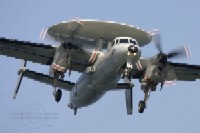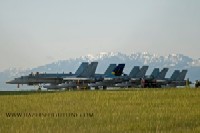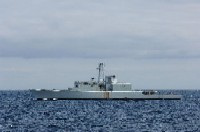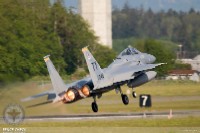Fury in the skies and on the
seas
By Cat George
Peninsula News Review
May 9th, 2007
 There
may be sinking ships and cannons firing, but it’s not your everyday game of
Battleship. Exercise Trident Fury,
hosted by the Maritime Forces Pacific, will bring together an international
group of naval, air and ground forces to conduct a simulated war in the skies
and seas of BC’s west coast for two weeks. Amongst the seamanship, ship
handling, combat manoeuvres, air defense, and strike missions, one ship will
actually head to its end at sea, and aerial drones and unmanned maritime targets
will come down in live fire exercises.
There
may be sinking ships and cannons firing, but it’s not your everyday game of
Battleship. Exercise Trident Fury,
hosted by the Maritime Forces Pacific, will bring together an international
group of naval, air and ground forces to conduct a simulated war in the skies
and seas of BC’s west coast for two weeks. Amongst the seamanship, ship
handling, combat manoeuvres, air defense, and strike missions, one ship will
actually head to its end at sea, and aerial drones and unmanned maritime targets
will come down in live fire exercises.
 “There’s
nothing like putting live weapons on target,” said Colonel John
McManus, who commands the Air Component of
Trident Fury. Now in its third
year, the exercise aims to prepare troops for potential real-world situations,
as well as help American and Canadian forces integrate. One main goal is
conducting the Operations Room Officer Course Sea Assessment, which supplies a
test of naval officer training.
“There’s
nothing like putting live weapons on target,” said Colonel John
McManus, who commands the Air Component of
Trident Fury. Now in its third
year, the exercise aims to prepare troops for potential real-world situations,
as well as help American and Canadian forces integrate. One main goal is
conducting the Operations Room Officer Course Sea Assessment, which supplies a
test of naval officer training.
 A
highlight of this year’s exercise will be the sinking of the ex-HMCS
Huron off the coast of Vancouver
Island. Rather than creating an artificial reef or selling the ship for scrap,
the retired destroyer will end its 34 years of service as a target for a
live-fire mission. It has taken two years to ready the ship for sinking in order
to comply with Environment Canada regulations; chemical storage containers,
mercury gauges, fuel tanks, loose paint and flaking rust were all removed before
the Huron could descend into
2,000 metres of water. All of the players in
Trident Fury, from the aircraft
through to ships, will have a chance to take a shot at the
Huron, with the sinking blow
expected to come from a torpedo on an American submarine.
A
highlight of this year’s exercise will be the sinking of the ex-HMCS
Huron off the coast of Vancouver
Island. Rather than creating an artificial reef or selling the ship for scrap,
the retired destroyer will end its 34 years of service as a target for a
live-fire mission. It has taken two years to ready the ship for sinking in order
to comply with Environment Canada regulations; chemical storage containers,
mercury gauges, fuel tanks, loose paint and flaking rust were all removed before
the Huron could descend into
2,000 metres of water. All of the players in
Trident Fury, from the aircraft
through to ships, will have a chance to take a shot at the
Huron, with the sinking blow
expected to come from a torpedo on an American submarine.
The more than 2,000 participants in
Trident Fury come from as far
afield as Australia, Texas, North Dakota and, closer to home, Spokane, Whidbey
Island, Comox and Victoria. The Royal Australian Air Force has brought the
Wedgetail, an
 airborne
early warning and control aircraft, one of six Boeing 737 NGs that has been
modified for surveillance and air combat capability. The rest of the forces,
which include 40 aircraft and eight major warships, are split between Canadian
and American representatives. HMC Ships
Algonquin, Regina, Vancouver
and Sasktoon represent the
Canadian naval contingent, while US Ships
Shoup, Ingraham, Navajo and
Curts, Coast Guard Cutter
Alert, and an American submarine
which could not be named, have come up from the United States for Trident Fury.
airborne
early warning and control aircraft, one of six Boeing 737 NGs that has been
modified for surveillance and air combat capability. The rest of the forces,
which include 40 aircraft and eight major warships, are split between Canadian
and American representatives. HMC Ships
Algonquin, Regina, Vancouver
and Sasktoon represent the
Canadian naval contingent, while US Ships
Shoup, Ingraham, Navajo and
Curts, Coast Guard Cutter
Alert, and an American submarine
which could not be named, have come up from the United States for Trident Fury.
In the scenario prepared for the exercise, a
stretch of northern BC represents the Orange team, a Communist country with
nuclear powers, while southern BC represents Blue, a powerful democratic country
with a growing presence in international politics. Tacticians on both teams will
have to take into account the presence of Gold (geographically represented by
the United States), a Communist area with an officially neutral position but
ideological support for Orange, the opposition forces. The scenario has a
backstory, too, with parallels to the current situation in north and south
Korea; Blue and Orange were originally one country, but split during a war in
1950-52. The activities during Trident
Fury compress six months of real time action into two weeks, escalating
from tensions and incidents to full-on simulated warfare. The scenario aims to
reflect a realistic real-world situation that forces might potentially face.
American and Canadian naval forces are split evenly between the two teams, while
aircraft have an opportunity to fly on both sides.
 “The
biggest value [of Trident Fury]
is the chance to integrate with so many different players,” said Major John
Edwards, call sign “Thug,” of the 114 Fighter Squadron with the Oregon Air
National Guard. “This is a great opportunity to work with the naval side and
also with Canada.” Edwards has flown in an F-15 Eagle fighter jet for 10 years.
Asked about the match-up between the F-15s and the Canadian fighter jets, the
Hornet, he said, “In close combat, the Hornet is very manoeuvrable. If it’s well
flown, you’d better be flying well too.”
“The
biggest value [of Trident Fury]
is the chance to integrate with so many different players,” said Major John
Edwards, call sign “Thug,” of the 114 Fighter Squadron with the Oregon Air
National Guard. “This is a great opportunity to work with the naval side and
also with Canada.” Edwards has flown in an F-15 Eagle fighter jet for 10 years.
Asked about the match-up between the F-15s and the Canadian fighter jets, the
Hornet, he said, “In close combat, the Hornet is very manoeuvrable. If it’s well
flown, you’d better be flying well too.”
Commodore Bruce Donaldson, the Pacific Fleet
Commander, who heads up Trident Fury
and commands the Maritime Component, admitted that the two weeks of the exercise
would be a tiring time for everyone involved. “I think I’ll have large suitcases
under my eyes,” he said. But the point of the exercise wasn’t lost on any of the
participants. “It’s a good exercise,” said Air Captain Derek Kauth, who flies a
Sea King helicopter, of last year’s
Trident Fury. The Sea Kings fly search and rescue, utility trips, hauls
supplies and people out to sea, and are an important aspect of the
anti-submarine warfare efforts. “You get to play with everybody.”
© Copyright 2007 Peninsula News Review
|

|
|
From right to left:
Canadian Halifax Class Frigate HMCS
Regina, American Oliver Hazard Perry Class Frigates USS CURTS and
INGRAHAM, Canadian Iroquois Class Destroyer HMCS
Algonquin and the American
Arleigh Burke Class Destroyer, USS SHOUP patrol the area off west coast
Vancouver Island May 9 2007. These five ships along with Canadian Frigate
HMCS Ottawa and the
refuelling ship, USNS JOHN ERICSSON, are part of a coalition force
participating in EX TRIDENT FURY 07 |
Ships photo and caption from:
http://www.canadaka.net/pic-12040.html
 There
may be sinking ships and cannons firing, but it’s not your everyday game of
Battleship. Exercise Trident Fury,
hosted by the Maritime Forces Pacific, will bring together an international
group of naval, air and ground forces to conduct a simulated war in the skies
and seas of BC’s west coast for two weeks. Amongst the seamanship, ship
handling, combat manoeuvres, air defense, and strike missions, one ship will
actually head to its end at sea, and aerial drones and unmanned maritime targets
will come down in live fire exercises.
There
may be sinking ships and cannons firing, but it’s not your everyday game of
Battleship. Exercise Trident Fury,
hosted by the Maritime Forces Pacific, will bring together an international
group of naval, air and ground forces to conduct a simulated war in the skies
and seas of BC’s west coast for two weeks. Amongst the seamanship, ship
handling, combat manoeuvres, air defense, and strike missions, one ship will
actually head to its end at sea, and aerial drones and unmanned maritime targets
will come down in live fire exercises.



